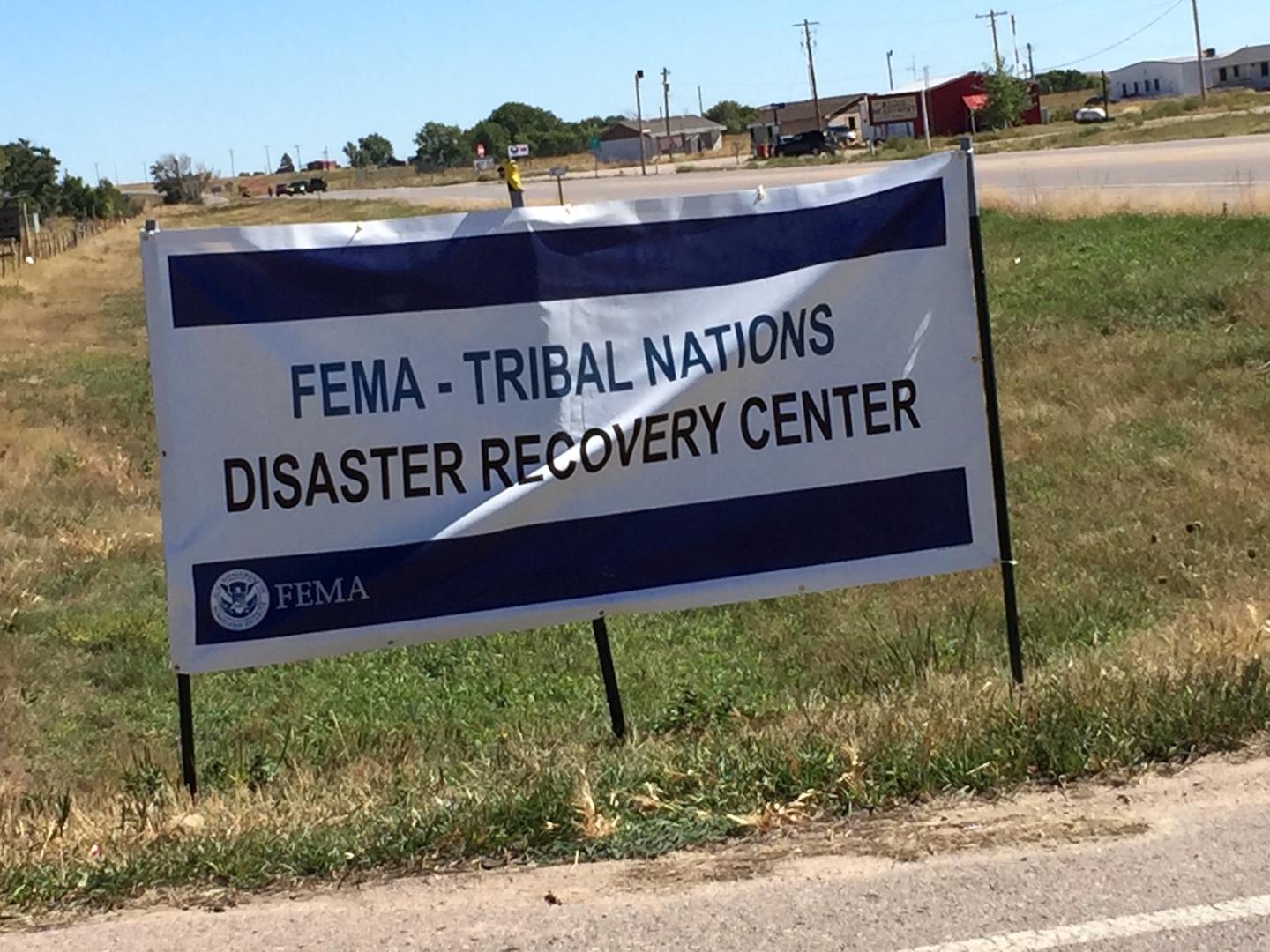![]()
This page provides procedural information regarding the Stafford Act declaration process and is intended for emergency managers, elected officials, media, and stakeholders interested in the formal declaration process.
All emergency and major disaster declarations are made solely at the discretion of the President of the United States.

Federally recognized tribal governments have the option to request a presidential disaster declaration independent of a state.
Declaration Process for Tribes
The Robert T. Stafford Disaster Relief and Emergency Assistance Act, 42 U.S.C. §§ 5121-5207 (the Stafford Act) §401 states in part that: "All requests for a declaration by the President that a major disaster exists shall be made by the Governor of the affected State." A State also includes the District of Columbia, Puerto Rico, the Virgin Islands, Guam, American Samoa, and the Commonwealth of the Northern Mariana Islands. The Republic of Marshall Islands and the Federated States of Micronesia are also eligible to request a declaration and receive assistance through the Compacts of Free Association.
As a result of the Sandy Recovery Improvement Act, federally recognized Indian tribal governments now have the option of pursuing a declaration directly from the President. FEMA has developed Tribal Declarations Pilot Guidance, which provides more detailed and specific guidance for Tribal requests.
FEMA has codified the declaration process at 44 C.F.R. Part §206, Subpart B.
This animation explains how federal assistance reaches communities after a disaster.If it is apparent that a Presidential disaster declaration may be necessary to assist in the recovery of the impacted area, the State or Indian tribal government should contact their FEMA Regional Office and request a joint Federal, State/Tribal Preliminary Damage Assessment (PDA). Local government representatives should be included, if possible.
Together, the team will conduct a thorough assessment of the impacted area to determine:
This information is included in the Governor or Tribal Chief Executive’s request to show that the disaster is of such severity and magnitude that effective response is beyond the capabilities of the State and the affected local governments or Indian tribal government and that supplemental federal assistance is necessary.
Go to the Preliminary Damage Assessments page

Once the PDA is complete and the State or Indian tribal government determines that the damage exceeds their resources, the Governor or Tribal Chief Executive may submit a declaration request to the President through their FEMA Regional Office. As part of the request, the Governor or Tribal Chief Executive must take appropriate action under State or Tribal law and direct the execution of the State or Tribal emergency plan. The Governor or Tribal Chief Executive shall furnish information on the nature and amount of State and local or Indian tribal government resources that have been or will be committed to alleviating the results of the disaster, provide an estimate of the amount and severity of damage and the impact on the private and public sectors, and provide an estimate of the type and amount of assistance needed under the Stafford Act. In addition, the Governor or Tribal Chief Executive must certify that, for the current disaster, State and local governments or Indian tribal government obligations and expenditures will comply with all applicable cost-sharing requirements.
Generally, the PDA is completed prior to the submission of the Governor or Tribal Chief Executive’s request for a major disaster declaration. However, when an obviously severe or catastrophic event occurs, the Governor or Tribal Chief Executive’s request may be submitted prior to completion of the PDA. 1 In such circumstances the major disaster will generally be limited to Public Assistance Categories A and/or B (which may be further limited to Direct Federal Assistance (DFA)) and Hazard Mitigation Assistance. For high-impact events where the level of damage to residences is empirically overwhelming, the declaration may also include Individual Assistance. Additional forms of assistance may be added at a later date, pending the completion of PDAs.
There are two types of disaster declarations provided for in the Stafford Act: emergency declarations and major disaster declarations. 2 Both declaration types authorize the President to provide supplemental federal disaster assistance. However, the events related to the two different types of declaration and scope and amount of assistance differ.
The President can declare an emergency for any occasion or instance when the President determines federal assistance is needed. Emergency declarations supplement State and local or Indian tribal government efforts in providing emergency services, such as the protection of lives, property, public health, and safety, or to lessen or avert the threat of a catastrophe in any part of the United States. The total amount of assistance provided for in a single emergency may not exceed $5 million. The President shall report to Congress if this amount is exceeded.
The Governor of the affected State or Tribal Chief Executive of the affected Tribe must submit a request to the President, through the appropriate Regional Administrator, within 30 days of the occurrence of the incident. The request must be based upon a finding that the situation is beyond the capability of the State and affected local governments or Indian tribal government and that supplemental federal emergency assistance is necessary to save lives and protect property, public health and safety, or to lessen or avert the threat of a disaster. In addition, the request must include:
A Governor or Tribal Chief Executive may request an emergency declaration in advance or anticipation of the imminent impact of an incident that threatens such destruction as could result in a major disaster. Such requests must meet all of the statutory and regulatory requirements for an emergency declaration request. Requests must demonstrate the existence of critical emergency protective measure needs prior to impact are beyond the capability of the State and affected local governments or Indian tribal government and identify specific unmet emergency needs that can be met through DFA. Such DFA may include, but is not limited to, personnel, equipment, supplies, and evacuation assistance. Pre-positioning of assets generally does not require a declaration. Assistance made available under a pre-disaster emergency declaration will typically be Category B (emergency protective measures), limited to DFA. FEMA may require damage assessments and/or verified cost estimates if additional types of assistance are requested.
When an emergency exists for which the primary responsibility rests with the Federal government, the President may declare an emergency without a request from the Governor of the affected State or the Tribal Chief Executive of the affected Tribe. Such an emergency declaration does not prevent the Governor or Tribal Chief Executive from subsequently requesting a major disaster declaration for other unmet needs caused by the event.
The President can declare a major disaster for any natural event, including any hurricane, tornado, storm, high water, wind-driven water, tidal wave, tsunami, earthquake, volcanic eruption, landslide, mudslide, snowstorm, or drought, or, regardless of cause, fire, flood, or explosion, that the President determines has caused damage of such severity that it is beyond the combined capabilities of state and local governments to respond. A major disaster declaration provides a wide range of federal assistance programs for individuals and public infrastructure, including funds for both emergency and permanent work.
The Governor of the affected State or Tribal Chief Executive of the affected Tribe must submit the request to the President through the appropriate Regional Administrator within 30 days of the occurrence of the incident. The request must based upon a finding that the situation is beyond the capability of the State and affected local governments or Indian tribal government and that supplemental federal assistance is necessary. In addition the request must include:
Not all programs, however, are activated for every disaster. The determination of which programs are authorized is based on the types of assistance specified in the Governor or Tribal Chief Executive’s request and the needs identified during the joint PDA and subsequent PDAs. FEMA disaster assistance programs are as follows:
Factors: When evaluating requests for major disasters and making recommendations to the President, FEMA considers the following factors 6 :
(b) Individual Assistance Program
2 FEMA has established a third type of declaration, Fire Management Assistance Grant (FMAG) declarations, through regulation. That process differs significantly from the emergency and major disaster processes. Read more information regarding the Fire Management Assistance Grant program.
4 This section provides guidance regarding the circumstances under which pre-disaster emergency declarations may be considered and the types of assistance which may be made available, as required by Stafford Act Section 502(c) (42 U.S.C. § 5192(c)).
6 44 C.F.R. §206.48. The regulation includes a chart titled “Average Amount of Assistance per Disaster.” This chart is out of date and is no longer relevant to the declarations process.
The Governor or Tribal Chief Executive can appeal the denial of a major disaster or emergency declaration request. The appeal must be submitted within 30 days of the date of the denial letter and should include additional information justifying the need for supplemental federal assistance.
Add-ons: The Governor, the Governor’s Authorized Representative (GAR), or Tribal Chief Executive can request designation of additional counties and programs within 30 days of the declaration or the end of the incident period, whichever is later. The Governor, GAR, or Tribal Chief Executive may submit an extension request within the 30-day period, providing a valid reason supporting an extension.
Cost Share Adjustments: The authority to adjust the Public Assistance cost share resides with the President. FEMA will recommend an increase in the federal share to not more than 90% for Public Assistance when a disaster is so extraordinary that actual federal obligations under the Stafford Act, excluding administrative cost, meet or exceed a qualifying threshold. 7
Appeals: Post declaration determinations are generally subject to a one-time appeal. Such appeals must be submitted within 30 days of the denial letter. This deadline may be extended by FEMA, upon request of the State or Indian tribal government. Extension requests must be submitted within the 30 day deadline.
7 44 C.F.R. §206.47(b). The amount is adjusted annually for inflation using the Consumer Price Index for All Urban Consumers.